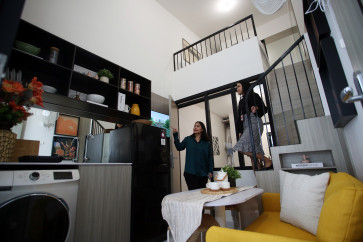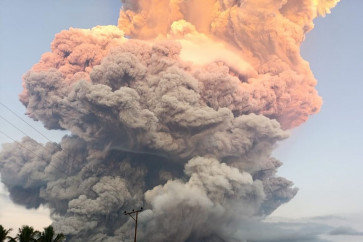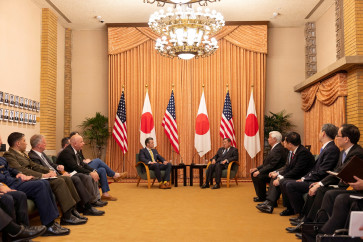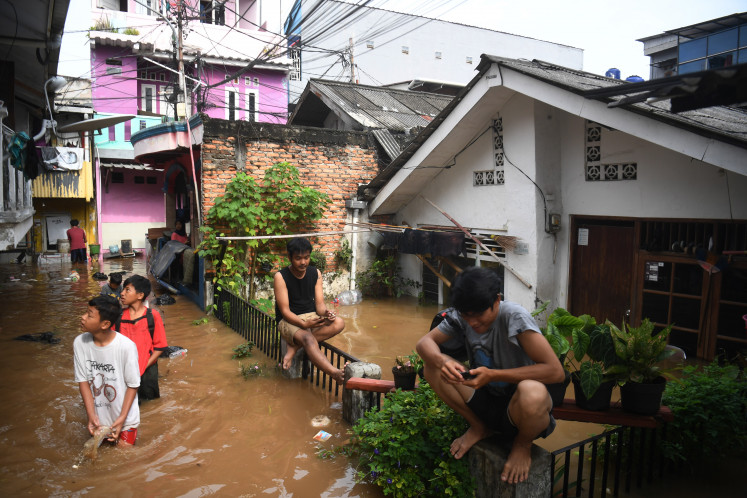Popular Reads
Top Results
Can't find what you're looking for?
View all search resultsPopular Reads
Top Results
Can't find what you're looking for?
View all search resultsMount Fuji’s safety still under a cloud
The central government and the Yamanashi and Shizuoka prefectural governments have drawn up a series of measures to limit the number of climbers who scale Mt. Fuji, in a bid to ease congestion on the trails snaking up the World Heritage site.
Change text size
Gift Premium Articles
to Anyone
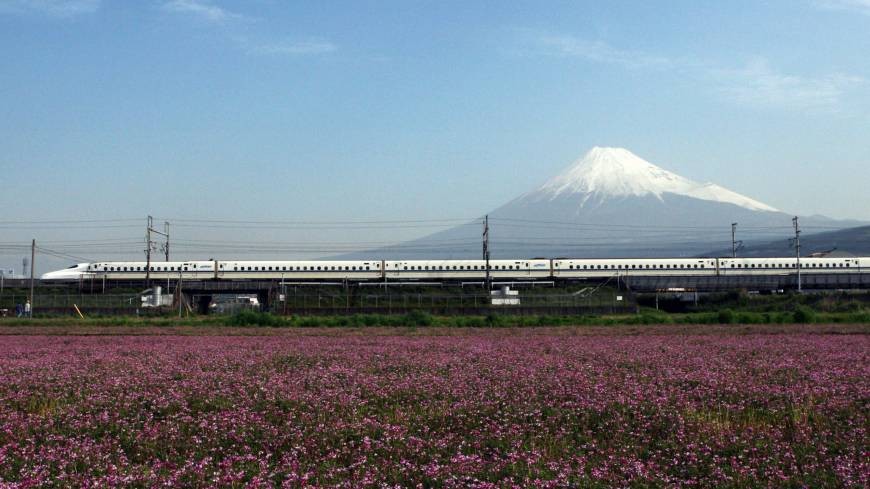 Central Japan Railway Co.'s N700 'Nozomi' series shinkansen travels past Mount Fuji in Shizuoka Prefecture in April 2010. (Bloomberg/File photo)
Central Japan Railway Co.'s N700 'Nozomi' series shinkansen travels past Mount Fuji in Shizuoka Prefecture in April 2010. (Bloomberg/File photo)
J
apan central government and the Yamanashi and Shizuoka prefectural governments have drawn up a series of measures to limit the number of climbers who scale Mt. Fuji, in a bid to ease congestion on the trails snaking up the World Heritage site.
Access to the mountain will not be restricted, and the planned measures center on urging climbers to stagger the dates of their hikes. This has created doubt over whether the planned steps will actually improve climber safety at times when the mountain is especially busy, such as when crowds flock to the summit to watch the sunrise.
Spiritual integrity at risk
Under the plan, the daily maximum number of climbers on the Yoshida climbing trail from Yamanashi Prefecture will be 4,000, while on the Fujinomiya trail on the Shizuoka side, it will be held to 2,000.
Compared with the busiest day recorded during the 2017 summer climbing season, these figures represent a 12 percent drop and a 25 percent drop, respectively. No maximum limits were set for the Gotenba and Subashiri trails, which both start in Shizuoka Prefecture, because high traffic is not expected there.
When UNESCO officially designated Mt. Fuji as a World Heritage site in 2013, it also requested conservation measures be taken to protect the mountain.
“The huge number of pilgrims during the two summer months ... works against the spiritual atmosphere of the mountain,” UNESCO explained, indicating the mountain’s spiritual integrity, an incredibly precious value, could be undermined. The UN body said a “visitor management strategy” will be drawn up.
From 2015 to 2017, both Yamanashi and Shizuoka prefectures analyzed the number of climbers by using GPS and other methods. The prefectures on March 27 determined the steps to be implemented that they would submit to UNESCO by the end of November.
“The survey took three years, but we gained a clear picture of the targets we need to achieve to eliminate dangerous congestion on the mountain,” a confident Shizuoka Gov. Heita Kawakatsu said.
The maximums were determined based on the benchmark of having up to 1.25 climbers per square meter on the trails, a criterion both prefectures established was sufficient to prevent climbers from bumping into each other. After considering data that included climber movement patterns based on analyses conducted during the survey, the maximums were set as targets designed to prevent congestion on the Yoshida and Fujinomiya trails.
The plan aims to ensure the number of daily climbers exceeds 4,000 for no more than three days on the Yoshida trail, and 2,000 for no more than two days on the Fujinomiya trail during the upcoming summer season, which runs from July to September.
Both prefectures explained the first objective is to “reduce the number of days with heavy trafffic by about half.” No numerical restrictions will be placed on climbers heading up the mountain. A “traffic forecast calendar” will be released, and climbers will be urged to avoid typically crowded times such as weekends and holidays.
It is hoped some climbers will adjust their schedules and scale the mountain when fewer people are expected to be there. However, during the summer of 2017, the Yoshida trail exceeded this maximum figure only for five days, and the Fujinomiya trail only for four days.
It is a stretch to say the prefectural governments have laid out lofty goals in terms of climber numbers.
“This is a really soft tactic. I doubt it will be very effective,” said Shigeru Horiuchi, mayor of Fujiyoshida, Yamanashi Prefecture.
Traffic peaks around sunrise
The biggest problem on the mountain has been potentially dangerous situations when large numbers of climbers assemble near the summit to watch the sunrise.
A survey both prefectures conducted in August last year near the eighth and ninth stations around the time dawn broke revealed about 1,600 climbers congregated near the summit over an about three-hour period. The backpacks of climbers who had come to a standstill because of congestion would often come close to making contact with the people behind them, and there were fears climbers could fall over like dominoes.
Said Yasuhiko Ota, a 36-year-old climbing guide who plies the Yoshida trail: “The mountain trail gets very narrow near the ninth station, so even 1,000 climbers per day creates congestion. The 4,000-person cap is too high.”
Rock and a hard place
So why did the prefectural governments shy away from taking stricter measures? A Yamanashi prefectural government senior official said: “It was difficult to strike a balance that would satisfy both the tourism industry and environmental conservationists. We couldn’t afford to open that Pandora’s box.”
Mt. Fuji is a precious tourism resource. The amount tourists spent in the neighboring 12 cities, towns and villages near the mountain’s base totaled about ¥171.45 billion (US$1.6 billion) on the Yamanashi side in 2016, and about ¥507.09 billion on the Shizuoka side in fiscal 2016.
Kikumi Sasuga, who heads an association of shops and other facilities on Mt. Fuji’s fifth station, opposes setting any restriction on climber numbers.
“A daily cap would make climbers hesitate to come, and that would deal our businesses a body blow,” said Sasuga, 88.
By contrast, Hisao Sugawara, the 74-year-old leader of an association that studies nature on Mt. Fuji, insists such a limit is necessary. “The seeds of nonnative plants that had been clinging to climbers’ shoes have since started growing all over the place,” Sugawara said. “Restricting access to the mountain is precisely what is needed.”
Heritage status could be nixed
There have been cases overseas in which World Heritage status has been stripped because of failure to comply with requests made by UNESCO.
In 2004, the Dresden Elbe Valley in Germany was registered as a World Heritage site as a landscape that fit harmoniously with its baroque buildings. However, when the local government decided to construct a bridge across the river to ease traffic congestion, UNESCO called for the plan to be changed to an underground tunnel. The local authorities did not accept this demand, so five years later the site’s registration was withdrawn.
“If the situation [on Mt. Fuji] doesn’t change, I think further action will be required,” said Yasuyoshi Okada, a professor at Kokushikan University and deputy chairman of the Japan ICOMOS National Committee, which preserves World Heritage sites.
While Mt. Fuji was being considered for World Heritage registration, significant improvements were made in the aspect of environmental protection, such as preventing the dumping of garbage on the mountain.
However, how to deal with climber traffic was omitted from the to-do list. Simply responding to the UNESCO requests alone will not be enough to continue the protection of the mountain’s value into the future.
Mt. Fuji, World Heritage site
At 3,776 meters, Mt. Fuji is Japan’s tallest mountain. It straddles the border of Yamanashi and Shizuoka prefectures. It was registered as a World Heritage site in 2013 in recognition of its spiritual powers, which have been the object of faith for pilgrims, and its impact on the development of Western art through ukiyo-e prints by Katsushika Hokusai and others. Since climber surveys started in 2005, the mountain’s busiest year was 2010, when about 320,000 visitors hiked up the mountain. In 2017, about 280,000 climbers scaled Mt. Fuji.
Designation heading for danger zone?
It is not unusual for UNESCO to attach conditions or make requests when registering a new World Heritage site.
Take the listing “Sites of Japan’s Meiji Industrial Revolution: Iron and Steel, Shipbuilding and Coal Mining,” which includes the Imperial Steel Works, Japan, in Kitakyushu and the Hashima Coal Mine, commonly known as Gunkanjima (Battleship island), in Nagasaki. When registering these World Heritage sites in 2015, UNESCO called for visitor threshold levels to be established — similar to what the U.N. body did when it registered Mt. Fuji. This was mainly to “mitigate any potential adverse impact.”
The central government and local authorities are currently considering their options after examining these issues.
If a World Heritage site’s value is jeopardized, UNESCO can designate it “World Heritage in Danger,” which is like a referee issuing a yellow card. The historic center of Vienna was registered as a World Heritage site in 2001, but it was later listed as World Heritage in Danger in 2017 because nearby redevelopment projects were having a negative impact on the environment and streetscape. As of 2017, 38 cultural sites and 16 natural sites were deemed to be in danger.
UNESCO’s World Heritage Committee will examine the steps taken to control the number of climbers on Mt. Fuji. An official of the Cultural Affairs Agency’s Monuments and Sites Division said: “At the moment, we don’t know how these steps will be assessed. It’s possible UNESCO might make additional requests.”
This article appeared on The Japan News newspaper website, which is a member of Asia News Network and a media partner of The Jakarta Post

